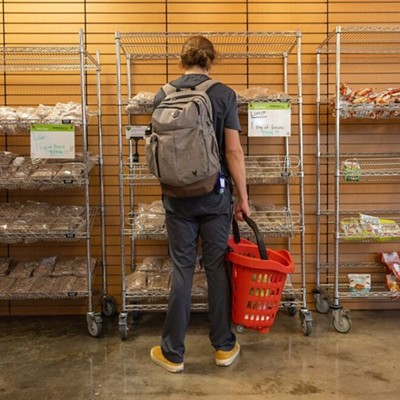You guys need to seriously up your game. Yeah, I know I haven't written one of these since the end of June, but that doesn't let you off the hook for not providing me with any suggestions last time. I'm getting the impression you don't think much of the leftovers pieces. Too bad.
Seriously, though, I had to go all the way back to the beginning to track down this week's suggestion, since The Hat merely provided a reference to it. Our very own Katharine Shilcutt has been practically begging me to make this ice cream, dropping it into the comments section repeatedly. Her diligence finally paid off, and I was the beneficiary.
I'm typically not terribly big on sweets. Give me the choice between chocolate or a cheeseburger, and the burger wins, hands down, at least 90 percent of the time. I've always been that way. Even when I'm craving dessert, I tend to steer toward the more temperate zone on the cart, rather than rushing headlong into hyperglycemia. You might find it odd, then, that I was so excited about making David Lebovitz's Salted Butter Caramel Ice Cream.
Yes, sugar flavored ice-cream with little nuggets of crunchy sugar mixed in is an extremely sweet proposition. "Salted" is the hook, here. Out of all the forms of direct-sugar-injection that fill the dessert world, salted caramel stands alone, for me. When made properly, caramel is anything but one-note sweet, despite its saccharine provenance, and the addition of salt as both underline and counterpoint serves to elevate the sweet treat well beyond the candy aisle.
If you've never done it yourself, let me tell you that caramel is extremely simple to make. It requires attention to detail, but not much skill. As Lebovitz notes in the recipe, the trick to making really good caramel is patience and nerves of steel. You have to almost burn it. You have to take it so close to burning, in fact, that one spare moment on the stove top might legitimately ruin your whole batch.
If you can stay your hand and wait for that point-of-almost-no-return, your caramel will be complex - nutty and deeply flavored, with a smoky character reminiscent of fire-toasted marshmallows - instead of simply tasting like brown sugar. It's worth it. Add to that good-quality butter (I use cultured, whose tangy edge adds just a little bit of extra character) and cream, sprinkle on a good amount of flaky sea salt, and you've got a heck of a dessert.
Yes, it's sweet. It's also rich and almost savory from the butter and cream, complex from the near-burning of the sugar (there's a reason people misapply the term "caramelized" to the searing and browning of a whole host of savory foods), with a nice salty punch.
For this recipe, you get to make caramel twice. The first go round is actually just a simple praline or brittle, poured out thin on a silpat-lined sheet pan, and broken into shards once cooled. Move quickly when pouring, or you won't get the praline as thin as you'd like. I didn't. I was lucky to have any left when it was time to churn, as my kids kept stealing chunks of it when I wasn't looking. They didn't even wait for it to cool properly, blistering their fingers with pilfered candy. Serves 'em right.
The second batch of caramel is the real deal, and is the foundation for the ice cream base. It starts out the same way, taking sugar to the edge of burning. This time, it's pulled back by swirling in cold butter at the last second, off the heat. Make sure you're using a big enough pot for your caramel, because adding the butter creates steam, causing the scalding hot caramel to roil around in the pot like some sort of delicious primordial ooze. A bit of cream and milk get added, and everything cooks on low heat until combined.
The only "tricky" step here is tempering the eggs. You don't want scrambled eggs in your ice cream, so tempering is a must. It's really not a big deal, just add small amounts of hot caramel to your yolks, stirring constantly, until the eggs are warmed up, then add them slowly back to the pot of caramel, whisking constantly. From there, it's just a matter of adding this mix to some milk, and stirring until cooled. An eight-hour chill before churning makes this a definite two-day project.
Once it was properly chilled, my batch took about 20 minutes to churn to the proper consistency in my stand mixer's ice cream attachment. A couple of hours in the freezer firmed things up, and I was enjoying some of the best ice-cream I've ever had. It was definitely sweet; a little goes a long way. It also had all those other elements about which I waxed rhapsodic earlier. I'll save you another round of purple prose.
I will, however, mention my favorite thing about the ice cream. The wafer-thin, super-crunchy shards of salted caramel praline in the mix mirrored the texture and effect of flaky sea salt, offering wonderful textural counterpoint to the soft ice cream, and providing a burst of flavor, both salty and sweet. It was truly delicious stuff. Despite a relatively involved process and two days time, it was also truly simple. Go make some. In the meantime, what's next?
Follow Eating Our Words on Facebook and on Twitter @EatingOurWords






